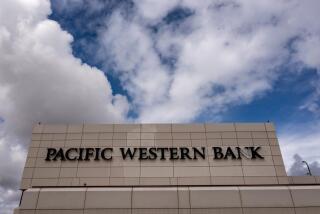Security Pacific Corp. Has Record First-Quarter Profit
- Share via
Security Pacific Corp. reported Monday that profit rose to a record level in the first quarter, buoyed by gains in all three of its major lines of banking.
The Los Angeles-based parent of Security Pacific National Bank said profit for the quarter totaled $179.3 million, the highest ever for a single three-month period at the bank and up 22% from the first quarter of 1988.
Two major New York banks, Chase Manhattan and Manufacturers Hanover, reported lower first-quarter earnings on Monday.
The increase at Security Pacific, the nation’s sixth-largest banking company, came as a result of strong performance in all three of its major business areas--its California bank, its banks in five other states and its financial-services subsidiaries, such as international banking, according to Richard J. Flamson III, chairman and chief executive.
Continuing efforts to cut overhead also paid off. Non-interest expenses, which cover staff and other overhead, were $755.4 million for the quarter, up just 3% over the year-earlier period. For the last year, the bank has been striving to keep the overhead increases under 5%. And one-third of the increase for the quarter was the result of its acquisition of Nevada National Bancorporation in January, the bank said.
Staff expenses, however, may show a sharper increase over the remainder of 1989 because Security Pacific has joined the other big California banks in extending branch hours. The biggest cost is expected to come from the bank’s decision to open Saturdays, from 9 a.m. to 1 p.m., which started last week.
Higher Spread in California
But, as Security Pacific’s balance sheet showed, California’s major banks can afford such extra costs because widening spreads between loan yields and retail deposit costs are boosting their interest income.
This spread is higher in California than in most parts of the country because banks here tend to pay lower interest rates to customers for deposits while interest rates charged on loans to customers are similar to those elsewhere.
For the first quarter, Security Pacific’s interest income was $733.8 million, up $102.4 million--16%--from a year ago. The bank attributed the increase to a higher interest-rate spread and a 7% increase in average assets. The bank also benefited from its expanded lending in two areas where spreads are traditionally high, real estate and consumer loans.
The bank’s return on assets and return on equity, two key measures of a bank’s performance, were both up for the quarter and above industry averages in California. The ROA was 0.90%, up from 0.81% a year ago, and ROE was 19.4%, up from 18.4%.
Security Pacific reported some problems with its domestic loans, stemming chiefly from troubled real estate loans at its Arizona banking subsidiary. Non-performing loans--those on which payments are at least 90 days past due--increased slightly in the quarter compared to the end of 1988 primarily as a result of Arizona real estate problems.
John F. Kooken, the chief financial officer, said the fact that the bank posted a record profit despite its loan problems in Arizona demonstrated the value of its earnings diversity.
At Chase Manhattan Corp., the nation’s second-largest banking company, profit fell 52% to $131.9 million from a year earlier. The bank said increases in interest income and fees were offset by lower income from foreign exchange trading and other trading activities.
Manufacturers Hanover Corp., the nation’s seventh-largest banking company, said its profit for the quarter dropped nearly 27% to $103 million from $141 million in the same period a year ago.
A gain of $40 million in tax benefits and from the sale of a subsidiary, however, contributed to last year’s first-quarter earnings. Without the one-time gain, the bank’s earnings would have been slightly higher than a year ago.
More to Read
Inside the business of entertainment
The Wide Shot brings you news, analysis and insights on everything from streaming wars to production — and what it all means for the future.
You may occasionally receive promotional content from the Los Angeles Times.










